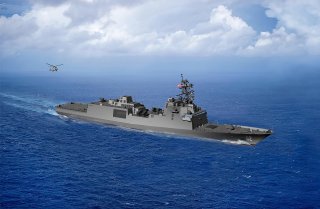Constellation-Class: The U.S. Navy’s New Frigates, Explained
The Constellation-class will be above all cost-effective.
Secretary of the Navy Kenneth Braithwaite has announced the name of the United States’ newest Guided Missile Frigates during a ceremony on the Constellation museum ship in Baltimore, Maryland.
Speaking about the origins of the name, Braithwaite explained its origins in the aftermath of the American Revolution. “George Washington personally selected the name Constellation. It refers to the constellation of stars that have adorned our flag, from the original circle of thirteen to the fifteen gracing the Star-Spangled Banner across the harbor above Fort McHenry, to the fifty that fly from the mast of every Navy ship today,” he explained.
The Constellation name is steeped with history. The first ship named Constellation was a thirty-eight-gun frigate that served after the Revolution and was decommissioned in 1853, whereas the second Constellation built after the first Constellation’s decommissioning was the Navy’s last wind-powered sailing warship. Most recently, a Kitty Hawk-class aircraft carrier also named Constellation served in Vietnam, the first Gulf War and supported operations in Afghanistan and Iraq until it was decommissioned in 2003.
Guided Missile Frigate
Braithwaite emphasized that the plan for the new Constellation-class is to counter near-peer rivals and help get closer to a 355-ship Navy. “While providing an unmatched capability and survivability for the twenty-first century, Constellation Class Frigates will honor our Navy’s historic beginnings as we continue to operate around the world in today’s era of Great Power Competition.”
A potential hurdle to getting to a 355-ship Navy is a matter of dollars and cents. One of the goals of the Constellation-class project was to modify existing ship designs to meet U.S. Navy requirements. The service is currently suffering from so-called “sticker shock,” a reference to the astronomically-high sticker prices of previous Navy projects and in particular the Littoral Combat Ship program
The LCS is a group of two different classes of ships designed to undertake a number of missions in shallow coastal waters but have been considered both an engineering failure and have cost taxpayers considerably more than initially projected.
The Navy would like the Constellation-class to be able to conduct low-intensity missions overseas in partnership with foreign navies as well as ocean patrol like the LCS ships have done. But, that doesn’t mean that the frigates wouldn’t be able to hold their own in a high-end fight.
The Navy has also expressed a desire for the smaller frigates to keep up with surface groups in order to conduct anti-submarine warfare and counter surface ships, in addition defending against boat swarms and conducting convoy defense with an emphasis on already-existing systems rather than newer untested systems in order to keep costs down.
Postscript
As a guided-missile frigate, it is believed that the Constellation-class will be armed with vertical missile launch tubes, though it could be a platform, which the Navy moves to arm with directed energy weapons in the future. Though details are currently a bit scant, watch this topic for further future updates.
Caleb Larson is a defense writer for the National Interest. He holds a Master of Public Policy and covers U.S. and Russian security, European defense issues, and German politics and culture.
Image: Reuters.

